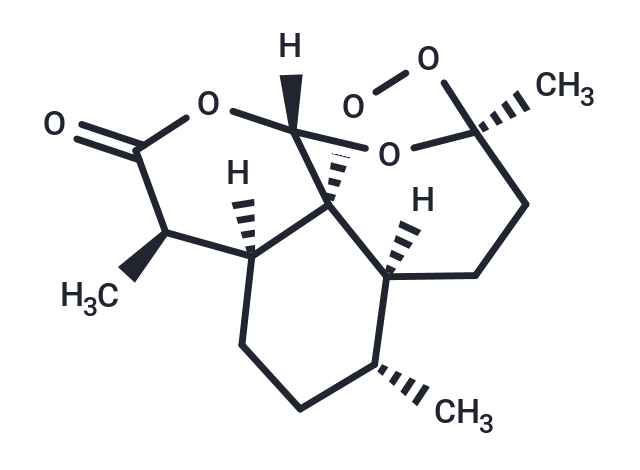Shopping Cart
Remove All Your shopping cart is currently empty
Your shopping cart is currently empty
Artemisinin (Qinghaosu) is a natural product, a sesquiterpene lactone, derived from Artemisia annua. Artemisinin has anti-malarial activity, as well as neuroprotective and anti-tumor activity.

| Pack Size | Price | USA Warehouse | Global Warehouse | Quantity |
|---|---|---|---|---|
| 100 mg | $30 | In Stock | In Stock | |
| 500 mg | $64 | In Stock | In Stock | |
| 1 g | $93 | In Stock | In Stock | |
| 1 mL x 10 mM (in DMSO) | $50 | In Stock | In Stock |
| Description | Artemisinin (Qinghaosu) is a natural product, a sesquiterpene lactone, derived from Artemisia annua. Artemisinin has anti-malarial activity, as well as neuroprotective and anti-tumor activity. |
| In vitro | METHODS: A375 and Sk-Mel-28 cells were treated with Spautin-1 (2.5-20 µmol/L) for 24-72 h. Cell viability was determined by MTS assay. RESULTS: Spautin-1 significantly reduced the proliferation of A375 and SK-Mel-28 in a dose- and time-dependent manner. 72 h IC50 values of Spautin-1 on A375 and SK-Mel-28 were 1.830 and 2.062 µmol/L, respectively.[1] METHODS: K562 cells were treated with Imatinib mesylate (250 nM) for 12 h and Spautin-1 (10 µM) for 36 h. The expression levels of target proteins were detected by Western Blot. RESULTS: The autophagy in K562 cells was activated by Imatinib mesylate treatment, and the autophagy in K562 cells induced by Imatinib mesylate was strongly inhibited by Spautin-1. Spautin-1 strongly inhibited autophagy induced by Imatinib mesylate. [2] |
| In vivo | METHODS: To investigate the therapeutic potential for acute pancreatitis, Spautin-1 (2 mg/kg) was intraperitoneally injected into KunMing mice with cerulein or L-arginine induced pancreatitis. RESULTS: Spautin-1 effectively inhibited autophagic flux and ameliorated the pathogenesis of acute pancreatitis induced by cerulein or L-arginine. The effects of Spautin-1 in ameliorating acute pancreatitis were associated with impaired autophagic inhibition and alleviation of Ca2+ overload. [3] METHODS: To investigate the effects on cognitive and memory deficits after traumatic brain injury (TBI), Spautin-1 (10 mmol/uL, 2 uL) was injected into the left ventricle. RESULTS: Spautin-1 administration may attenuate mild TBI-induced cognitive and memory dysfunction in mice by activating caspase-3. [4] |
| Kinase Assay | Briefly, PC12 cells are lysed in lysis buffer and centrifuged at 12,500×g for 5 min 15 mL of cell lysate is incubated with 50 mL of 2X substrate working solution at room temperature for 30 min in 96-well plates. The fluorescence intensity is then determined by Infinite M200 PRO Multimode Microplate at an excitation wavelength of 490 nm and emission at 520 nm. The fluorescence intensity of each sample is normalized to the protein concentration of sample. All values of % caspase 3/7 activities are normalized to the control group. |
| Cell Research | Artemisinin is diluted in 0.01% DMSO. For this purpose, cells are cultivated in 96-well plates in DMEM, supplemented with insulin. The artemisinin, Dox, and DDP are added to media at different concentrations and the cells are cultivated for either 24 or 48 h. For this purpose artemisinin is diluted in 0.01% DMSO in media. After this time, 10 μL of the MTT dye solution (5 mg/mL in phosphate buffer saline) is added to the cells; the cells are incubated at the same conditions for 3 h. After centrifugation (1500 rpm, 5 min) the supernatant is removed. 100 μL of dimethyl sulfoxide is added to each well, to dissolve formazan. The absorption is measured, using a multi-well spectrophotometer at a wavelength of 540 nm. |
| Synonyms | Qinghaosu,Artemisinine, Qinghaosu, NSC 369397, Artemisinine |
| Molecular Weight | 282.33 |
| Formula | C15H22O5 |
| Cas No. | 63968-64-9 |
| Smiles | [H][C@@]12CC[C@@H](C)[C@]3([H])CC[C@]4(C)OO[C@@]13[C@]([H])(OC(=O)[C@@H]2C)O4 |
| Relative Density. | 1.24 g/cm3 |
| Storage | Powder: -20°C for 3 years | In solvent: -80°C for 1 year | Shipping with blue ice/Shipping at ambient temperature. | ||||||||||||||||||||||||||||||||||||||||
| Solubility Information | DMSO: 50 mg/mL (177.1 mM), Sonication is recommended. Ethanol: 21.2 mg/mL (75.09 mM), Sonication is recommended. | ||||||||||||||||||||||||||||||||||||||||
| In Vivo Formulation | 10% DMSO+40% PEG300+5% Tween 80+45% Saline: 2 mg/mL (7.08 mM), Sonication is recommended. Please add the solvents sequentially, clarifying the solution as much as possible before adding the next one. Dissolve by heating and/or sonication if necessary. Working solution is recommended to be prepared and used immediately. The formulation provided above is for reference purposes only. In vivo formulations may vary and should be modified based on specific experimental conditions. | ||||||||||||||||||||||||||||||||||||||||
Solution Preparation Table | |||||||||||||||||||||||||||||||||||||||||
Ethanol/DMSO
DMSO
| |||||||||||||||||||||||||||||||||||||||||
| Size | Quantity | Unit Price | Amount | Operation |
|---|

Copyright © 2015-2025 TargetMol Chemicals Inc. All Rights Reserved.